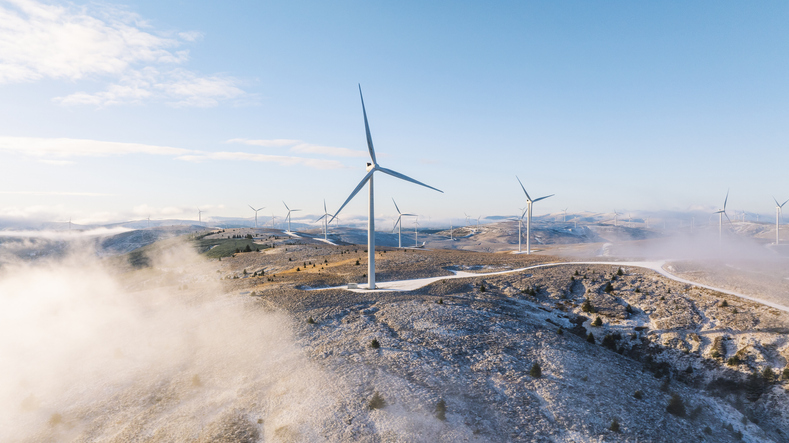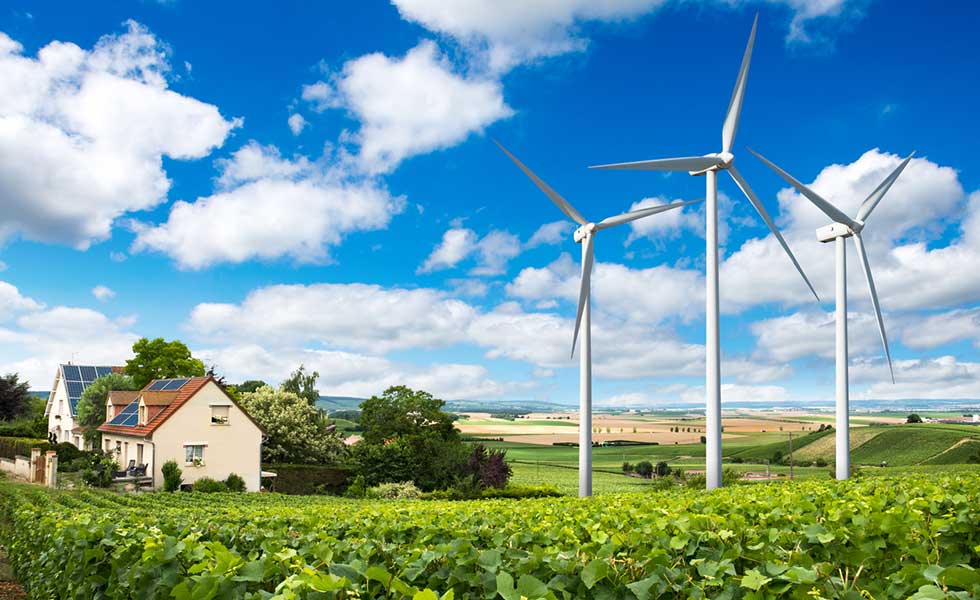
The big advantage of wind turbines is that wind energy is renewable, meaning it won't run out like fossil fuels and is not subject to price volatility. Once you get past the initial installation, operating costs are pretty low too.
On top of this, you could save between 20% and 80% a year on your energy bills and you may be able to sell some of the electricity you generate back to the grid.
As self-build homes are often sited on generous plots of land, they can be a good match for this type of renewable energy.
Energy and sustainability expert Jason Farrell, a certified master technician at Mechanic's Diary, breaks wind turbines down for us and explains exactly how they work.
How does a wind turbine work?
Wind turns the propeller-like blades of a turbine around a rotor, which spins a generator, which creates electricity. The wind doesn’t have to be particularly strong to work. The blades of most turbines will start turning at a wind speed of 3-5 metres per second, which is a gentle breeze.
All wind turbines use the same mechanics to generate electricity, from a micro wind turbine for home energy generation to enormous, off-shore windfarms. Wind farms produce the biggest proportion of the renewable electricity used in the UK.
How blade movement is turned into electricity
A wind turbine has blades that are shaped to turn as the wind passes across their surface. When wind flows across the blade, the air pressure on one side of the blade decreases.
Bring your dream home to life with expert advice, how to guides and design inspiration. Sign up for our newsletter and get two free tickets to a Homebuilding & Renovating Show near you.
The difference in air pressure across the blade's two sides creates lift and drag. The force of the lift is stronger than the drag and this causes the rotor to spin. The rotor connects to a generator and turns aerodynamic force into electricity.
A control system adjusts the blades and direction to harness the most wind power possible. This energy is then converted to AC power via an inverter. The electricity can then be used, stored in a solar battery bank, or is sold back to the National Grid.
Wind speed
In basic terms, the faster the wind speed, the faster the blades rotate on the turbine, meaning it should generate more power. However, all turbines have a maximum capacity, so exceptionally high wind speeds may not result in more electricity being generated.
Wind isn’t the only factor in efficiency either. The blades' size and shape, along with the mast's height and size of the rotor, can have just as much effect on efficiency as wind speed.

How wind turbine energy is turned into power
A domestic wind turbine has a generator that turns kinetic energy into electricity. This is connected by a cable to your home where it passes through an inverter to turn it from DC to AC power to make it compatible with your home’s wiring.
To power a domestic home you need a substantially sized wind turbine, according to The Renewable Energy Hub.
"If you want a wind turbine installed for domestic use then you really need to have a remote location where other buildings and infrastructure won’t get in the way," it explains on the website. "There are two different types of domestic wind turbine: Roof mounted and free-standing. The idea of putting a wind turbine on your roof seems like a good idea but the problem is that these don’t produce enough power to make you truly independent of the grid. You get more output from a free-standing wind turbine that operates similarly to the ones you see in wind farms."
How to store electricity from wind turbines
The electricity that flows from a wind turbine can be stored in batteries, such as this ECO-WORTHY lithium battery from Amazon. The two most common battery types for wind turbine battery storage systems are lithium-ion and lead-acid. While both lithium-ion and lead-acid batteries are effective storage solutions, there are differences in performance and costs.
However, before purchasing battery storage make sure it is the correct size for the amount of electricity your wind turbines are generating.
FAQs
How do I get electricity when there is no wind?
Wind doesn't always blow consistently, so you can't fully rely on it for power 24/7. You will likely need a backup energy source or batteries to store extra juice for those calm spells. Jason Farrell adds: “Not every location works - you need a spot with strong, steady winds.”
Is a wind turbine right for your specific self-build?
“It depends,” Farrell says. “First, evaluate your site. Is it open and windy like a field or by the coast? Do you have enough space? Think about your energy needs too - one turbine might not cut it. You'll have to figure out how to connect it to your home's electrical system and store extra energy for backup.”

Jason Farrell is a certified master technician at Mechanic's Diary. He has nearly 18 years of experience working on domestic, European, and foreign vehicles. He is ASE certified and has a Bachelor's Degree in Automotive Technology from Pittsburg State University. He’s been previously quoted in Car and Driver and Popular Mechanics.
What sites are suitable for a wind turbine?
Built-up areas where there are lots of tall buildings in the local vicinity aren’t typically suitable for turbines as there’s too much shelter and wind disturbance. Wooded areas are usually unsuitable for the same reason.
Open countryside and rural areas are more exposed to the elements and therefore wind. This is especially true on higher ground and coastal areas. You may also find that wide valleys, where the wind is channelled through, can also be suitable.
Do I need planning permission for a wind turbine?
You may need planning permission to install a wind turbine. This is usually the case if you live in a conservation area, but it’s also required if you’re also planning to install a heat pump or you need a tall mast for your turbine.
Jason Farrell concludes: “The bottom line is that wind turbines have their perks, but they're not ideal for every situation. It takes some careful planning and a solid chunk of change to get one up and running on your property.
“Weigh all the factors before taking the plunge. And hey, if wind power doesn't seem like the right fit, you can always explore solar panels or other renewable options instead.
EDITOR’S NOTE: An earlier version of this article included a quote from a purported expert whose credentials we have not been able to verify. The quote has been removed. We regret this lapse in our verification process and have updated our internal protocols to reduce the risk of recurrence.
Sam is based in Coventry and has been a news reporter for nearly 20 years. His work has featured in the Mirror, The Sun, MailOnline, the Independent, and news outlets throughout the world. As a copywriter, he has written for clients as diverse as Saint-Gobain, Michelin, Halfords Autocentre, Great British Heating, and Irwin Industrial Tools. During the pandemic, he converted a van into a mini-camper and is currently planning to convert his shed into an office and Star Wars shrine.

